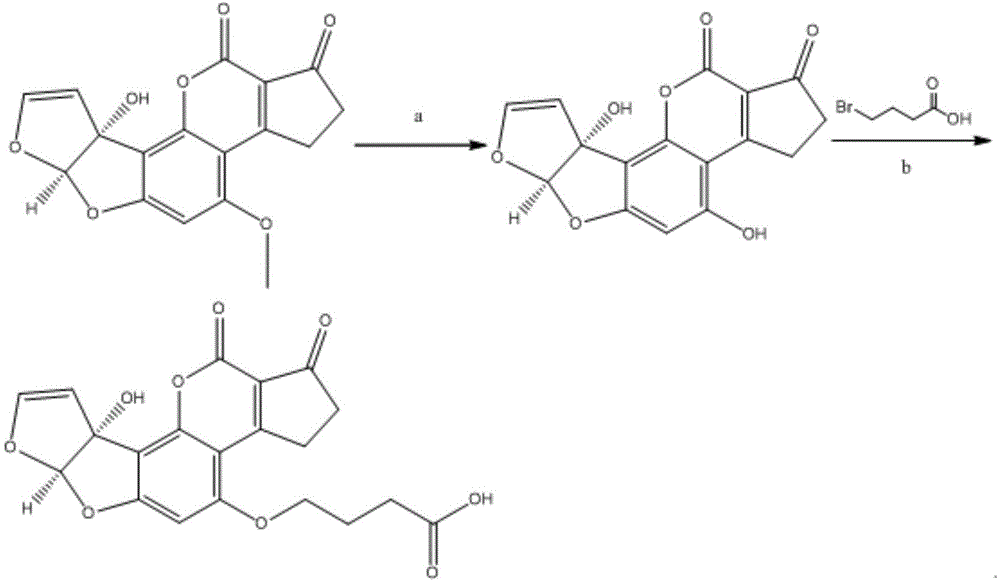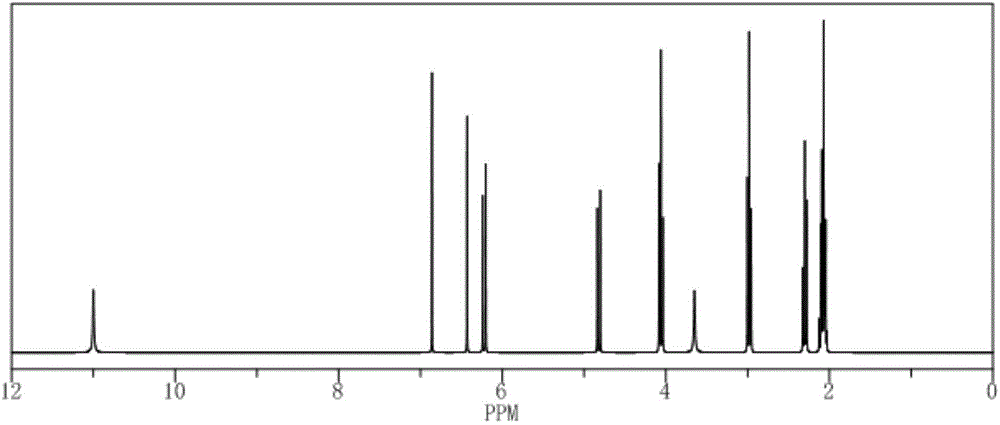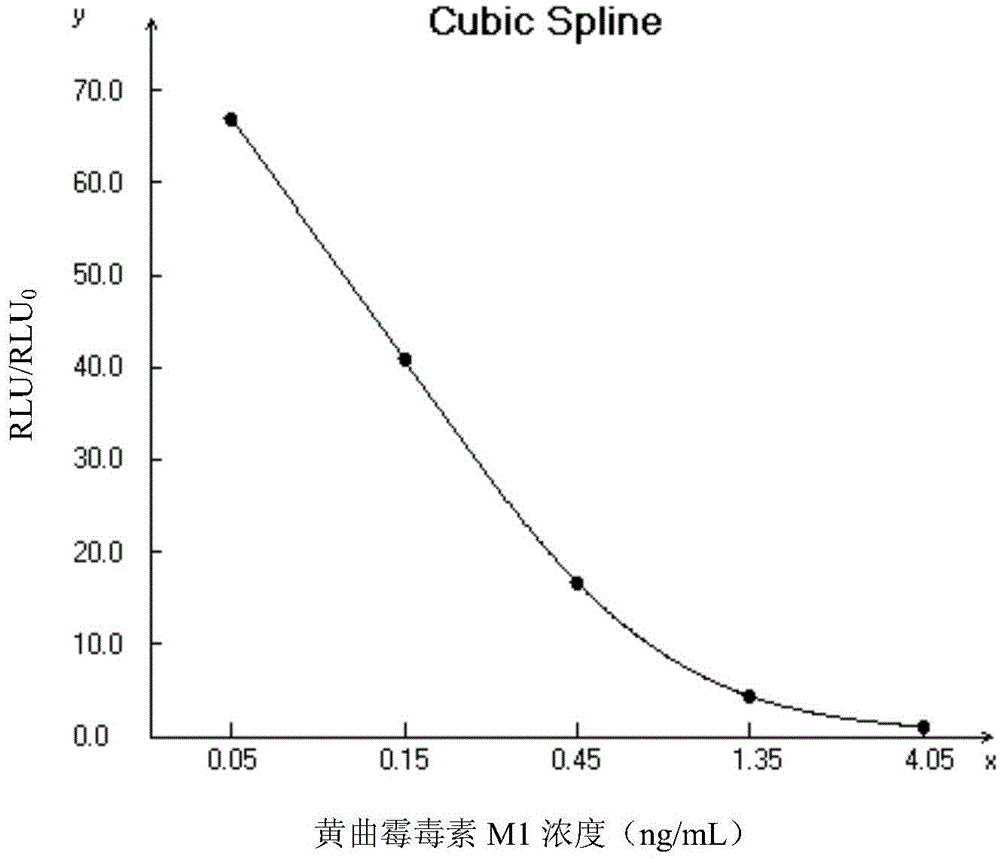Chemiluminescent kit for aflatoxin M1 and application thereof
An aflatoxin and chemiluminescence technology, applied in the field of immunological detection, can solve the problems of long time, cumbersome and time-consuming, limited samples for detection, etc., and achieve the effect of high sensitivity and improved sensitivity
- Summary
- Abstract
- Description
- Claims
- Application Information
AI Technical Summary
Problems solved by technology
Method used
Image
Examples
Embodiment 1
[0039] Embodiment 1: the preparation of hapten, antigen and monoclonal antibody
[0040] (1) Synthesis of aflatoxin M1 hapten
[0041] Reaction a: Take 15 mg of aflatoxin M, add 10 ml of dry acetonitrile to dissolve, add dropwise 1 ml of a solution containing 3 mg of boron tribromide, stir at room temperature for 4 hours, stop the reaction, detect, and complete the reaction of all raw materials. Stop the reaction, evaporate to dryness, add water and an appropriate amount of ethyl acetate, extract, stand still, separate layers, separate the water phase, dry over anhydrous sodium sulfate, and evaporate to dryness to obtain product 1.
[0042] Reaction b: Dissolve the product 1 in DMF, add 20 mg of sodium carbonate, stir, add 10 mg of bromobutyric acid, react at 60°C for 8 hours, and detect that all raw materials have been reacted, add water, extract with ethyl acetate, wash with water, dry and evaporate to dryness, and pass through silica gel for a short time. column to obtain ...
Embodiment 2
[0052] Example 2: Preparation of enzyme-labeled antigen
[0053] A, weigh 2mg HRP and dissolve in 0.5mL double distilled water; add 0.5mL newly prepared 0.06mol / L NaIO 4 Solution, 4 ℃ protected from light for 30 minutes;
[0054] B, add 0.5mL of 160mmol / L ethylene glycol, and react at room temperature for 30min;
[0055] C. Add 2 mg of aflatoxin M1-OVA, mix well, put it into a treated dialysis bag, dialyze in 1000 mL of 0.05 mmol / L sodium carbonate buffer, and overnight at 4°C;
[0056] D. Aspirate the dialysate into a 10mL centrifuge tube, add 0.25mL of newly prepared 5g / L NaBH 4 After mixing, place at 4°C for 2h; add an equal volume of saturated ammonium sulfate solution, act at 4°C for 30min, centrifuge at 3000rpm for 25min at 4°C, and discard the supernatant;
[0057] E, dissolve the precipitate in 1.5mL0.02mol / L pH7.4PBS, inhale into the dialysis bag, dialyze in 0.02mol / L pH7.4PBS, overnight at 4°C (replace PBS 3 times in the middle);
[0058] F, suck the liquid in th...
Embodiment 3
[0059] Embodiment 3: the establishment of CLEIA detection method
[0060] (1) Optimal concentration of coating antibody and enzyme-labeled antigen (square array method)
[0061] Coat the chemiluminescence plate longitudinally with serial dilutions of each coating antibody at 80.0, 40.0, 20.0, 10.0, 5.0, 2.5, 1.25, 0.625 μg / mL, 100 μL / well, place in a 37°C incubator for 2 hours, and shoot Dry; block with 150 μL / well blocking solution, place in a 37°C incubator for 2 hours, wash the plate once, and pat dry; add 50 μL / well of a series of diluted enzyme-labeled aflatoxin M1 antigen (1:1000 to 1:512000), Incubate at room temperature (20-25°C) for 15 minutes, wash the plate five times, and pat dry for the last time; add 50 μL / well of chemiluminescence A and B solutions respectively, and measure the luminescence intensity. Specificity determination was carried out with the coating antibody concentration and enzyme-labeled antigen dilution having obvious gradient changes in luminous ...
PUM
 Login to View More
Login to View More Abstract
Description
Claims
Application Information
 Login to View More
Login to View More - R&D
- Intellectual Property
- Life Sciences
- Materials
- Tech Scout
- Unparalleled Data Quality
- Higher Quality Content
- 60% Fewer Hallucinations
Browse by: Latest US Patents, China's latest patents, Technical Efficacy Thesaurus, Application Domain, Technology Topic, Popular Technical Reports.
© 2025 PatSnap. All rights reserved.Legal|Privacy policy|Modern Slavery Act Transparency Statement|Sitemap|About US| Contact US: help@patsnap.com



